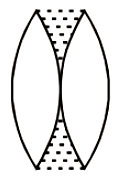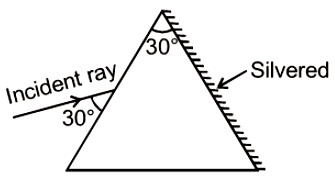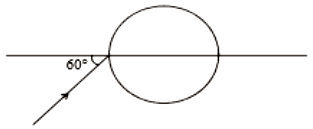A thin rod of length \(\frac{f}{3}\) lies along the axis of a concave mirror of focal length \(f\). One end of its magnified, real image touches an end of the rod. The length of the image is:
1.
\(f\)
2.
\(\dfrac{f}{2}\)
3.
\(2f\)
4.
\(\dfrac{f}{4}\)
The refractive index of the material of the prism for violet colour is 1.69 and that for red is 1.65. If the refractive index for mean colour is 1.66, the dispersive power of the material of the prism
1. 0.66
2. 0.06
3. 0.65
4. 0.69
Absolute refractive indices of glass and water are 3/2 and 4/3. The ratio of velocity of light in glass and water will be
1. 4:3
2. 8:7
3. 8:9
4. 3:4
A thin equiconvex lens of power \(P\) is cut into three parts \(A,B,\) and \(C\) as shown in the figure. If \(P_1,P_2\) and \(P_3\) are powers of the three parts respectively, then:

| 1. | \(P_1=P_2=P_3\) | 2. | \(P_1>P_2=P_3\) |
| 3. | \(P_1<P_2=P_3\) | 4. | \(P_2=P_3=2P_1\) |
Focal lengths of objective and eyepiece of a compound microscope are 2 cm and 6.25 cm respectively. An object AB is placed at a distance of 2.5 cm from the objective which forms the image B'A' as shown in the figure. Maximum magnifying power in this case is :

1. 10
2. 20
3. 5
4. 25
Two identical equiconvex thin lenses each of focal lengths 20 cm, made of material of refractive index 1.5 are placed coaxially in contact as shown. Now, the space between them is filled with a liquid of refractive index 1.5. The equivalent power of this arrangement will be:

1. + 5D
2. Zero
3. + 2.5D
4. + 0.5D
In the situation shown, the incident monochromatic ray retraces its path after its incidence on the silvered surface. The speed of light inside the prism will be

1.
2.
3.
4.
The sun (diameter D) subtends an angle radian at the pole of a concave mirror of focal length f. The diameter of the image of the sun formed by the mirror is:
1.
2.
3.
4.
The focal length of the plano-convex lens is 20 cm. If its plane surface is silvered, then
1. it behaves as a concave mirror of focal length 10 cm
2. it behaves as a convex mirror of focal length of 10 cm
3. it behaves as a concave mirror of focal length 20 cm
4. none of these
A ray of light falls on a transparent sphere as shown in the figure. If the final ray emerges from the sphere parallel to the horizontal diameter, then calculate the refractive index of the sphere. Consider that the sphere is kept in the air.

1.
2.
3.
4.


